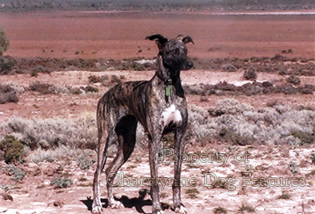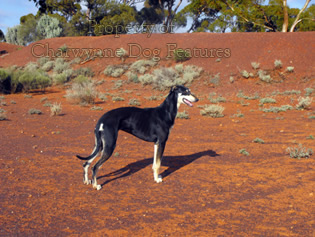936 SEEKING AN EXOTIC LURCHER
SEEKING AN EXOTIC LURCHER
by David Hancock
.jpg)
 Lurchermen are never shy of attempting the introduction of new, even exotic blood into their stock. The foundation of lurcher breeding here is usually rooted in Greyhound, Whippet and Collie blends, but I have seen a wider range of blood from further afield in recent years than ever before. This may be because more foreign sighthound breeds are now in residence, with the Maltese, Sicilian and North African breeds coming in and the Silken Windhound creating fresh interest. But I have seen blends of Malinois and Greyhound, Briard and Whippet, Azawakh and Dobermann and an Afghan Hound-Greyhound mix in recent years. Some such crosses may not have been planned but for the hunter seeking a specific quality, and knowing the breed to obtain it from, the doors are wide open. If, for example, you are seeking enhanced hearing then the prick-eared breeds from the Mediterranean countries offer material. If you are after improved stamina then Cretan Hounds, Australian Staghounds and our own trail-hounds offer new blood. If you need better scenting for your hunting ground, then, despite the risk of bringing in pendant ears, the Italian Segugios or the Bavarian Mountain Hounds have something to offer.
Lurchermen are never shy of attempting the introduction of new, even exotic blood into their stock. The foundation of lurcher breeding here is usually rooted in Greyhound, Whippet and Collie blends, but I have seen a wider range of blood from further afield in recent years than ever before. This may be because more foreign sighthound breeds are now in residence, with the Maltese, Sicilian and North African breeds coming in and the Silken Windhound creating fresh interest. But I have seen blends of Malinois and Greyhound, Briard and Whippet, Azawakh and Dobermann and an Afghan Hound-Greyhound mix in recent years. Some such crosses may not have been planned but for the hunter seeking a specific quality, and knowing the breed to obtain it from, the doors are wide open. If, for example, you are seeking enhanced hearing then the prick-eared breeds from the Mediterranean countries offer material. If you are after improved stamina then Cretan Hounds, Australian Staghounds and our own trail-hounds offer new blood. If you need better scenting for your hunting ground, then, despite the risk of bringing in pendant ears, the Italian Segugios or the Bavarian Mountain Hounds have something to offer.

The Saluki has been here as a breed for well over a century, with its cousin, the Sloughi now also imported and shown here. From further south in Africa, the Azawakh is proving increasingly popular on mainland Europe, with all three breeds coming long ago from a common source. The rabbit-dog of Malta or Pharaoh Hound, the Ibizan Hound and the Cirneco dell'Etna from Sicily provide the prick-eared constituent, with the little-known Cretan Hound impressing me the most of this hunting dog type. Running fast over loose rock is never easy, the hounds need really sound feet to do so. But all four of these Mediterranean breeds have quite remarkable hearing. For lurchermen, the Sicilian hound, coming from a more recent working background, perhaps offers the most.
Rather like its sister breeds from that part of the world, the Cirneco dell’Etna has superb hearing, aided no doubt by the bat-ears, and really durable feet, a basic feature so overlooked by many lurcher breeders here. Talking to an enthusiastic Italian breeder at a World Dog Show about the breed, he described them in his fractured English as a Trotting Sleuth Hound, meaning not an active Bloodhound but a tracking dog with an effortless trotting gait in the hunting field, backed by ‘infinite versatility’. He stressed their remarkable hearing, based on extremely sensitive ears, highly mobile ears, which can act independently, each one responding separately to the noise most acute on that side. He was proud of their field capability ahead of their appearance, waxing eloquent about the field trials available in the breed. Perhaps fanciers like him have ensured that the breed is still very much a sporting one, not mainly an exhibitor’s dog.
These Sicilian hounds have their own field trial regulations, covering shooting over game and trials without guns. Around 150 hounds are newly registered there each year. It is worth noting that their field trial regulations stipulate that: Dogs that do not make a tenacious effort in their work; that hesitate on a scent trail; that are distracted and do not cover the ground designated for their turn within the first five minutes will be eliminated. They are used to working with ferrets and at 46 to 50 cms (18 to 20 inches) lack the legginess of the 22 to 29 inch Ibizan Hound, but display a squarer torso than the similar Pharaoh Hound. Like the Cretan Hound they use an effortless energy-conserving trot in the hunt, relying more on their remarkable agility, superb hearing, keen sense of smell and lightning-fast reactions than sheer speed. Crossed with a Whippet, their blood would have much to contribute to our hunting dog scene, although I’m not sure that their bat-ears wouldn’t have problems in a climate famous for cold winds. With hunting dogs, it always has to be 'horses for courses'..jpg)
Australian hunters have made good use of imported sighthound blood, blending the blood of Salukis, Borzois and Scottish Deerhounds with the long-utilised Greyhound source. Kangaroo Dogs from the famous Wheatbelt line have strong Greyhound blood; Staghounds from the same line have clear Saluki blood, intended to improve their heat tolerance and long distance sprinting capability. The Wheatbelt Kangaroo Dogs remind me of the outstanding long-dogs once bred by Nuttall of Clitheroe, who, I believe, used a purebred Deerhound sire to a retired track or coursing Greyhound dam. Brian Plummer once described them as ‘truly magnificent animals…leg weakness, a common fault in deerhounds and in first-cross deerhound hybrids was practically unknown in these kennels, partly due to the judicious selection of both sire and dam by Nuttall and partly due to careful feeding of the whelps at his kennels.’ I see similarities between these dogs and those of Dave Platts, with his superbly-bred 'English Deerhounds'. Great breeders produce great dogs, but they are reliant on the blend that works - as always in the lurcher world!